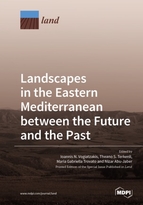Landscapes in the Eastern Mediterranean between the Future and the Past
A special issue of Land (ISSN 2073-445X).
Deadline for manuscript submissions: closed (31 December 2017) | Viewed by 67164
Special Issue Editors
Interests: ecology and biogeography of Mediterranean islands and mountains; the links between geomorphology and vegetation distribution patterns; predictive vegetation and habitat mapping; landscape based approach to nature conservation delivery; effectiveness of protected areas for biodiversity conservation; effects of landscape structure and habitat quality on biodiversity; spatial scale effects on ecosystem services and sustainability assessment
Special Issues, Collections and Topics in MDPI journals
Interests: geographies of everyday life; landscape studies; tourism and development; identities and globalization; participatory governance
Special Issues, Collections and Topics in MDPI journals
Interests: migration, conflict and the role of landscape planning and design; everyday landscape practices; cultural landscapes design; landscape risk assessment; landscape decision support system; reading and mapping the landscape
Interests: surface and groundwater resources and their shaping and interaction with the landscape; climate change as a key to understanding landscape changes; human interventions that shape the landscape to maximize available resources; pedagogical approaches to explain the importance of sustainability as a cornerstone for planning and the role of understanding landscape in attaining that goal
Special Issue Information
Dear Colleagues,
Landscapes have long been viewed as ‘multi-functional’, integrating ecological, economic, socio-cultural, historical, and aesthetic dimensions. Landscape science and public awareness in Europe have been progressing by leaps and bounds. The challenges involved in landscape-related issues and fields, however, are multiple and refer to landscape stewardship and protection, as well as to the development of comprehensive theoretical and methodological approaches, in tandem with public sensitization and participatory governance, and in coordination with appropriate top-down planning and policy instruments. Landscape scale approaches are fundamental to the understanding of past and present cultural evolution and are now considered to be an appropriate spatial framework for the analysis of sustainability. Methods and tools of landscape analysis and intervention have also gone a long way, since their early development, in Europe and the U.S. Although significant progress has been made, there remain many issues which are understudied or not investigated at all—at least in a Mediterranean context. This Special Issue will focus on the application of landscape theory and practice in the Eastern Mediterranean and mainly, but not exclusively, report on the outcomes of an international conference held in Jordan, in December, 2015, with the title “Landscapes of Eastern Mediterranean: Challenges, Opportunities, Prospects and Accomplishments”. The focus of this Special Issue, landscapes of the Eastern Mediterranean region, thus, constitutes a timely area of research interest, not only because these landscapes have so far been understudied, but also as a rich site of strikingly variegated, long-standing multi-cultural human-environmental interactions. These interactions, resting on and taking shape through millennia of continuity in tradition, have been striving to adapt to technological advances, while currently juggling with manifold and multi-layered socio-economic and climate–environmental crises.
Dr. Ioannis N. Vogiatzakis
Prof. Theano S. Terkenli
Dr. Maria Gabriella Trovato
Prof. Nizar Abu-Jaber
Guest Editors
Manuscript Submission Information
Manuscripts should be submitted online at www.mdpi.com by registering and logging in to this website. Once you are registered, click here to go to the submission form. Manuscripts can be submitted until the deadline. All submissions that pass pre-check are peer-reviewed. Accepted papers will be published continuously in the journal (as soon as accepted) and will be listed together on the special issue website. Research articles, review articles as well as short communications are invited. For planned papers, a title and short abstract (about 100 words) can be sent to the Editorial Office for announcement on this website. Submitted manuscripts should not have been published previously, nor be under consideration for publication elsewhere (except conference proceedings papers). All manuscripts are thoroughly refereed through a single-blind peer-review process. A guide for authors and other relevant information for submission of manuscripts is available on the Instructions for Authors page. Land is an international peer-reviewed open access monthly journal published by MDPI.
Please visit the Instructions for Authors page before submitting a manuscript.
The Article Processing Charge (APC) for publication in this open access journal is 2600 CHF (Swiss Francs).
Submitted papers should be well formatted and use good English. Authors may use MDPI's
English editing service prior to publication or during author revisions.








